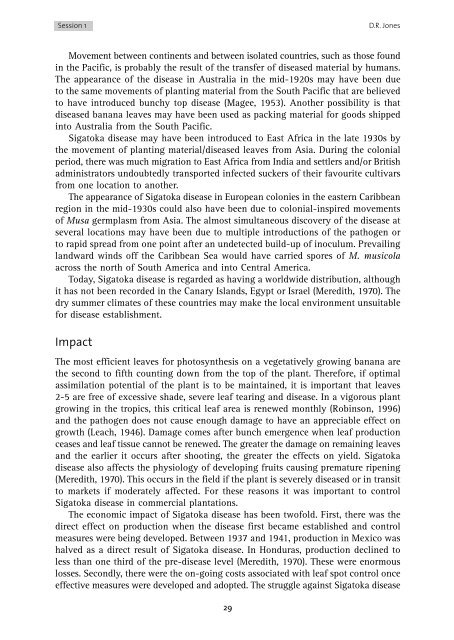Mycosphaerella leaf spot diseases of bananas - CBS
Mycosphaerella leaf spot diseases of bananas - CBS
Mycosphaerella leaf spot diseases of bananas - CBS
You also want an ePaper? Increase the reach of your titles
YUMPU automatically turns print PDFs into web optimized ePapers that Google loves.
Session 1<br />
D.R. Jones<br />
Movement between continents and between isolated countries, such as those found<br />
in the Pacific, is probably the result <strong>of</strong> the transfer <strong>of</strong> diseased material by humans.<br />
The appearance <strong>of</strong> the disease in Australia in the mid-1920s may have been due<br />
to the same movements <strong>of</strong> planting material from the South Pacific that are believed<br />
to have introduced bunchy top disease (Magee, 1953). Another possibility is that<br />
diseased banana leaves may have been used as packing material for goods shipped<br />
into Australia from the South Pacific.<br />
Sigatoka disease may have been introduced to East Africa in the late 1930s by<br />
the movement <strong>of</strong> planting material/diseased leaves from Asia. During the colonial<br />
period, there was much migration to East Africa from India and settlers and/or British<br />
administrators undoubtedly transported infected suckers <strong>of</strong> their favourite cultivars<br />
from one location to another.<br />
The appearance <strong>of</strong> Sigatoka disease in European colonies in the eastern Caribbean<br />
region in the mid-1930s could also have been due to colonial-inspired movements<br />
<strong>of</strong> Musa germplasm from Asia. The almost simultaneous discovery <strong>of</strong> the disease at<br />
several locations may have been due to multiple introductions <strong>of</strong> the pathogen or<br />
to rapid spread from one point after an undetected build-up <strong>of</strong> inoculum. Prevailing<br />
landward winds <strong>of</strong>f the Caribbean Sea would have carried spores <strong>of</strong> M. musicola<br />
across the north <strong>of</strong> South America and into Central America.<br />
Today, Sigatoka disease is regarded as having a worldwide distribution, although<br />
it has not been recorded in the Canary Islands, Egypt or Israel (Meredith, 1970). The<br />
dry summer climates <strong>of</strong> these countries may make the local environment unsuitable<br />
for disease establishment.<br />
Impact<br />
The most efficient leaves for photosynthesis on a vegetatively growing banana are<br />
the second to fifth counting down from the top <strong>of</strong> the plant. Therefore, if optimal<br />
assimilation potential <strong>of</strong> the plant is to be maintained, it is important that leaves<br />
2-5 are free <strong>of</strong> excessive shade, severe <strong>leaf</strong> tearing and disease. In a vigorous plant<br />
growing in the tropics, this critical <strong>leaf</strong> area is renewed monthly (Robinson, 1996)<br />
and the pathogen does not cause enough damage to have an appreciable effect on<br />
growth (Leach, 1946). Damage comes after bunch emergence when <strong>leaf</strong> production<br />
ceases and <strong>leaf</strong> tissue cannot be renewed. The greater the damage on remaining leaves<br />
and the earlier it occurs after shooting, the greater the effects on yield. Sigatoka<br />
disease also affects the physiology <strong>of</strong> developing fruits causing premature ripening<br />
(Meredith, 1970). This occurs in the field if the plant is severely diseased or in transit<br />
to markets if moderately affected. For these reasons it was important to control<br />
Sigatoka disease in commercial plantations.<br />
The economic impact <strong>of</strong> Sigatoka disease has been tw<strong>of</strong>old. First, there was the<br />
direct effect on production when the disease first became established and control<br />
measures were being developed. Between 1937 and 1941, production in Mexico was<br />
halved as a direct result <strong>of</strong> Sigatoka disease. In Honduras, production declined to<br />
less than one third <strong>of</strong> the pre-disease level (Meredith, 1970). These were enormous<br />
losses. Secondly, there were the on-going costs associated with <strong>leaf</strong> <strong>spot</strong> control once<br />
effective measures were developed and adopted. The struggle against Sigatoka disease<br />
29

















